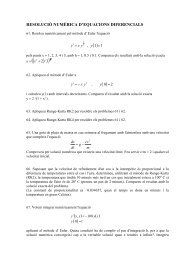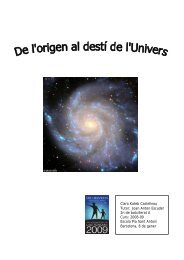Universitat de - Departament d'Astronomia i Meteorologia ...
Universitat de - Departament d'Astronomia i Meteorologia ...
Universitat de - Departament d'Astronomia i Meteorologia ...
You also want an ePaper? Increase the reach of your titles
YUMPU automatically turns print PDFs into web optimized ePapers that Google loves.
8 Chapter 1. Introduction and background<br />
Table 1.2: Types and location of catalogued LMXBs.<br />
Location Total XPs Bursters Z sources Atoll sources Transients REXBs<br />
SMC 0 0 0 0 0 0 0<br />
LMC 2 0 0 0 0 0 0<br />
Galaxy 147 5 63 6 18 75 35<br />
Total 149 5 63 6 18 75 35<br />
including 5 X-ray transients. Approximately half of LMXBs are transients. REXBs<br />
will be discussed in Sect. 1.1.3.<br />
The galactic latitu<strong>de</strong> distribution of the 147 galactic LMXBs has a mean of +0.4 ◦ ,<br />
and a standard <strong>de</strong>viation of 12.2 ◦ , to be compared with the 4.6 ◦ value obtained<br />
for HMXBs. It is clear the higher scatter in galactic latitu<strong>de</strong>, compatible with<br />
Population II sources. In fact, 13 LMXBs are located in globular clusters.<br />
1.1.3 Radio emitting X-ray binaries<br />
The first X-ray binary known to display radio emission was Sco X-1 in the late 1960’s.<br />
Since then, many X-ray binaries have been <strong>de</strong>tected at radio wavelengths with flux<br />
<strong>de</strong>nsities ≥ 0.1–1 mJy. Moreover, the flux <strong>de</strong>nsities <strong>de</strong>tected at cm radio wavelengths<br />
are produced in small angular scales, and cannot be produced by thermal emission<br />
mechanisms.<br />
In this context, the most efficient known mechanism for production of intense<br />
radio emission from astronomical sources is the synchrotron emission mechanism, in<br />
which highly relativistic electrons interacting with magnetic fields produce intense<br />
radio emission which tends to be linearly polarized. The observed radio emission can<br />
be explained by assuming a spatial distribution of non-thermal relativistic electrons,<br />
usually with a power-law energy distribution, interacting with magnetic fields.<br />
Since some REXBs, like SS 433, were found to display elongated or jet-like<br />
features, like in AGNs and quasars, it was proposed that flows of relativistic elec-<br />
trons were ejected perpendicular to the accretion disk, and were responsible for<br />
synchrotron radio emission in the presence of a magnetic field. Several mo<strong>de</strong>ls have<br />
been proposed for the formation and collimation of the jets, including the presence






